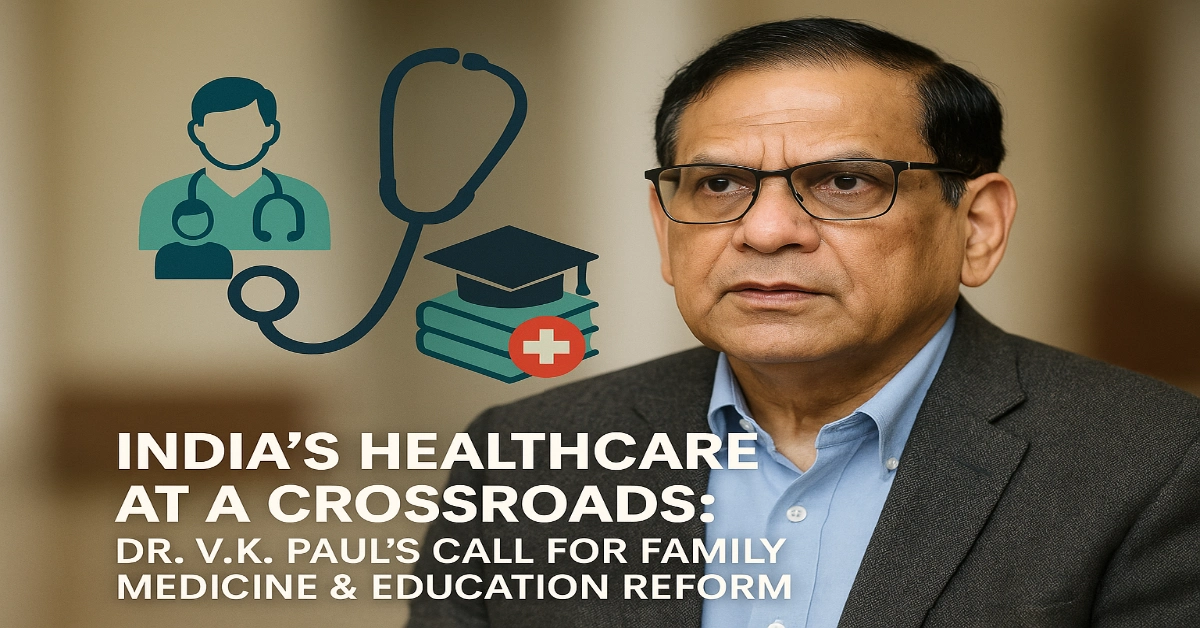NITI Aayog on Healthcare Reform: India suffers from critical deficiencies in healthcare. The system’s structural gaps are becoming increasingly stark amid rising chronic diseases, growing health inequities, and evolving demographic pressures.
In a recent policy dialogue, Dr V.K. Paul, NITI Aayog’s Member (Health), delivered a clear warning: incremental fixes won’t suffice. What India needs is a fundamental overhaul, centered on family medicine, emergency medicine, and a revamp of medical education.
Below, we reflect on the challenges and propose directions that policymakers, institutions, and civil society must consider.
Dr Paul Calls for Medical Education Overhaul
Tripling the Doctor-Patient Ratio by 2040
Dr Paul argues that the WHO benchmark of one doctor per 1,000 people, while acceptable for low-income countries, is inadequate for India’s ambitions. Instead, he proposes aiming for three doctors per 1,000 by 2040.
This is not mere idealism, it’s a recognition that to serve a diverse, ageing, chronic-disease-prone–prone population, India needs much more robust human resources in health.
Addressing the Specialist Shortage
His analysis reveals alarming gaps in specialist supply:
- At the current training rate of ~5,500 general surgeons per year, it would take 34 years to reach lower-middle-income country averages, and 69 years to reach high-income benchmarks.
- For psychiatrists, India currently has 0.7 per 100,000 population, compared to LMIC averages of ~2 per 100,000. Closing that gap would take 23 years at the current pace.
- In cardiology and other advanced specialties, the “waiting time” to meet global norms stretches into multiple decades under status quo assumptions.
These are not just abstract numbers: they translate into denied care, long waiting lists, and overburdened tertiary centers.
Curriculum Reform: Beyond the Silos of Specialty
One of Dr Paul’s strongest critiques is of medical education’s current structure:
- The MBBS curriculum is too compartmentalised and pays scant attention to internal medicine, psychiatry, geriatrics, chronic disease management, etc. Some specialties may receive only three to four weeks of exposure.
- The internship structure is similarly constrained: how can a graduate master management of conditions like schizophrenia or diabetes with just a few weeks of exposure?
- In many advanced health systems, becoming a competent family physician may take 10 years; India attempts to compress all required knowledge into five-and-a-half years.
He argues that the medical education machinery must evolve to produce graduates capable of holistic, continuous, community-oriented care, not just narrow specialty technicians.
Mainstreaming Family Medicine and Emergency Medicine
For Dr Paul, these are not optional extras, they are linchpins of a resilient healthcare model:
Family Medicine
- Currently, India has fewer than 100 postgraduate seats in family medicine, a glaring mismatch with the need for generalist physicians who manage chronic conditions, elder care, mental health, and continuity of care.
- He calls for expansion of these seats and suggests adopting models like AIIMS, where family medicine can be integrated without always needing a standalone department.
Emergency Medicine
- Often treated as an afterthought, emergency services in many medical colleges are grossly underdeveloped.
- Dr Paul describes scenarios in which one resident handles 30 patients with no consultant oversight, a recipe for compromised care.
- He advocates making emergency medicine mandatory in all new medical colleges.
Recasting Health as Economic Infrastructure
Perhaps the philosophical underpinning of his address is this: health is not a drain on the budget, but an engine of national productivity.
He calls for a shift in mindset: viewing health workers as critical to “human capital” and forging cross-ministry coordination with the private sector in partnerships for scale.
Challenges & Realities on the Ground
Dr Paul’s vision is bold, and many obstacles stand in the way. Below are key challenges and trade-offs that must be acknowledged:
- Institutional inertia: Medical schools, regulatory bodies, specialty departments, and legacy hierarchies may resist shifting power toward generalist training.
- Faculty shortage: For family medicine and emergency medicine to scale, India needs trainers with those competencies; many institutions lack this depth.
- Funding constraints: Expansion of seats, infrastructure, and curriculum overhaul require large investments. Priorities in health budgets are often crowded.
- Rural vs urban disparities: Even if aggregate numbers improve, distribution is key, many doctors remain concentrated in cities.
- Cultural biases: Among medical students, prestige still skews toward super-specialties. Generalist careers (family medicine) may be viewed as less glamorous.
- Integration issues: Primary care, hospital care, specialty care, and public health must connect; fragmentation undermines continuity.
Read Also: Medical College Expansion in India: CSS Phase 1-2-3 Explained
What Needs to Be Done
To translate Dr Paul’s vision into reality, multiple actors must act in concert. Here are some actionable strategies:
Regulatory & Policy Reforms
- Empower the National Medical Commission (NMC) to enforce expansion of family medicine and emergency medicine seats.
- Revise MBBS and postgraduate curricula to mandate rotations in chronic disease, geriatrics, psychiatry, community health, etc.
- Incentivize medical colleges to establish departments of family medicine even if small initially.
Capacity Building & Faculty Development
- Launch national faculty development programs in family medicine and emergency medicine.
- Encourage international collaborations and faculty exchanges.
- Fast-track “train the trainer” models to scale teaching capacity.
Incentives for Practice in Underserved Areas
- Offer loan forgiveness, salary bonuses, career progression advantages to doctors who serve rural or underserved areas in generalist roles.
- Use telemedicine, digital support, and hub-and-spoke models to support rural family physicians.
Strengthen Primary Health Infrastructure
- Ensure primary health centers (PHCs) and community health centers (CHCs) are well equipped, with reliable referral chains.
- Embed family physicians in primary care settings (not just in hospitals).
Public Awareness & Career Encouragement
- Run campaigns to elevate the prestige of generalist medicine and emergency service.
- Mentor medical students early in their training toward holistic care orientation.
Monitoring, Evaluation & Data Systems
- Create robust tracking of doctor distributions, specialty gaps, rural postings, and care outcomes.
- Use data feedback to continuously adjust quotas, funding, and performance.
Read Also: Monopoly in Medical Education in India: Ownership, Costs & Reforms 2025
What If India Fails or Succeeds?
If the status quo persists, shortages will deepen, health inequities will widen, tertiary care will continue to be overloaded, and India will struggle to meet the demands of noncommunicable diseases, ageing populations, and unforeseen health crises.
If Dr Paul’s vision is pursued, India could build a more resilient, accessible, equitable health system. A stronger base of family physicians and emergency services can reduce pressure on high-end hospitals, lower costs, and enhance preventive and longitudinal care.
Dr V.K. Paul’s address is not just a policy speech; it’s a clarion call. For too long, India has treated health as a reactive, episodic system of specialty care. The future demands a pivot: toward generalist care, continuous relationships, and modernised medical education.
The path is challenging, but the stakes, public health, equity, and national development, make this a journey India cannot defer.

